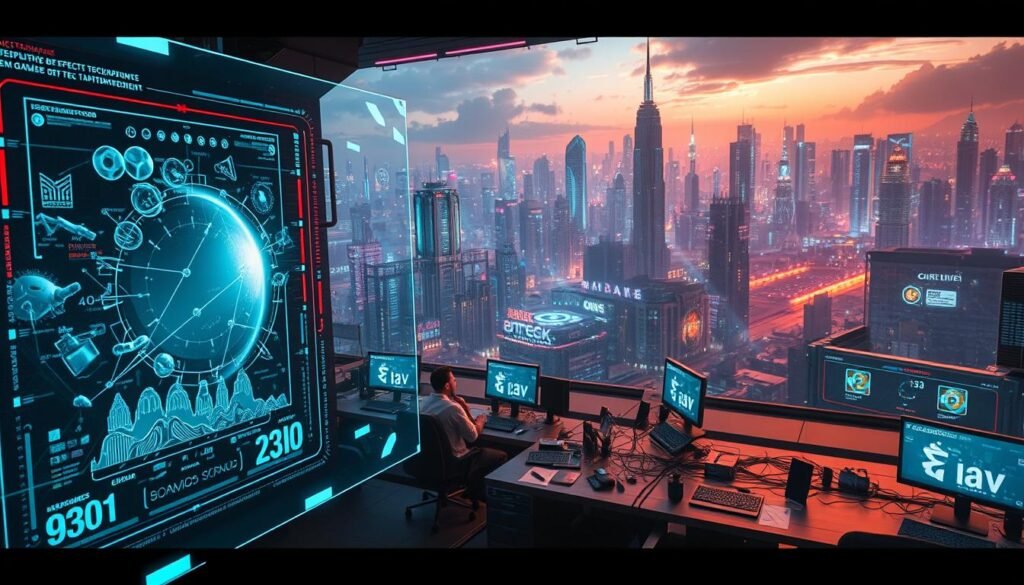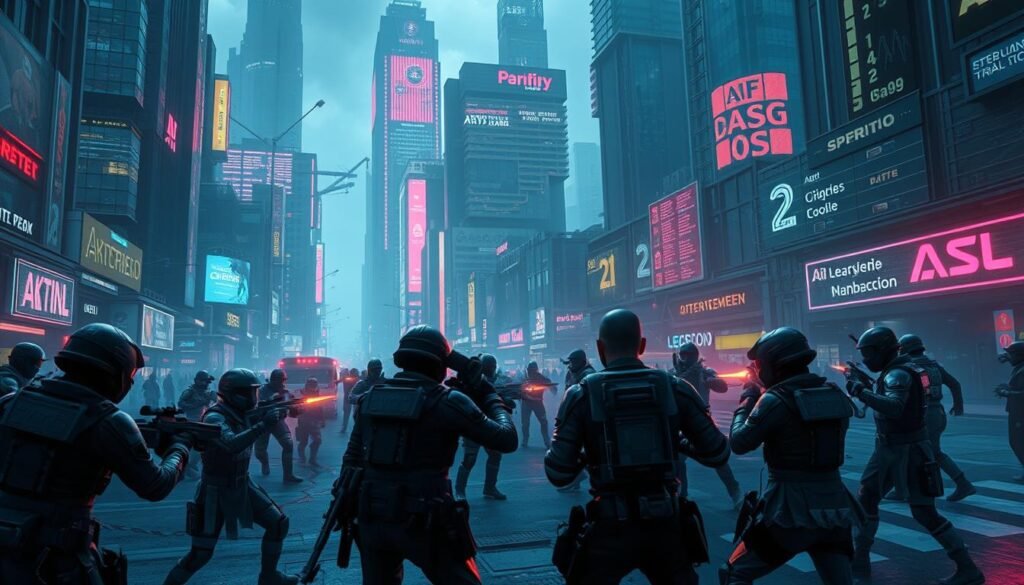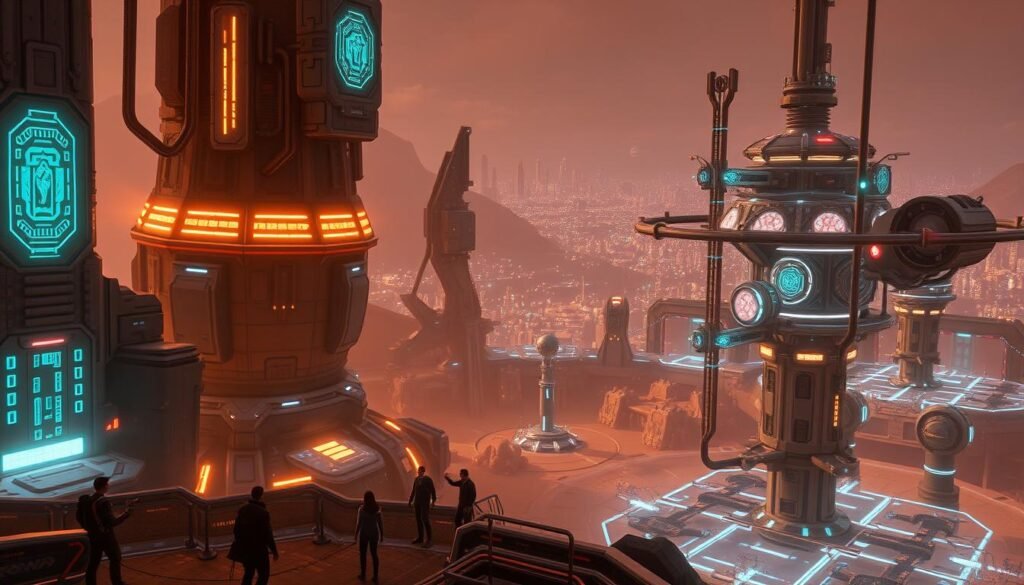Welcome to the exciting world of AI game development! If you’ve ever dreamed of creating immersive gaming experiences, you’re in the right place. Learning how to make a game with AI is now easier than ever for developers and creative enthusiasts.
The gaming industry is changing fast, thanks to AI. AI technologies are making games more dynamic and intelligent. Whether you’re a hobbyist or a game developer, learning AI can open up new possibilities for creating interactive worlds.
This guide will show you how to start using AI in game development. We’ll cover powerful tools, techniques, and strategies. These will help you create engaging games that go beyond traditional designs.
Key Takeaways
- AI is transforming game development across multiple genres
- Beginners can learn AI game development with the right resources
- Understanding core AI concepts is key for innovative game design
- Modern game development platforms support AI integration
- AI enables more responsive and intelligent game environments
Understanding the Basics of AI Game Development
Exploring AI in game development opens up new possibilities for creators. It combines artificial intelligence with game design, changing how we make interactive experiences. This results in more dynamic and engaging games.
AI has turned game development into something more than static experiences. Now, games can adapt and respond to players in real-time. This makes every game session unique.
Exploring AI Types in Game Mechanics
Game developers have many AI options:
- Decision Trees: These algorithms help characters make smart choices.
- Finite State Machines: They ensure AI behaviors are consistent and predictable.
- Neural Networks: These advanced systems learn and adapt during gameplay.
Essential AI Development Tools
To make AI-powered games, you need special tools. Frameworks like Unity’s ML-Agents and Unreal Engine are great for this.
Key Programming Concepts
Knowing basic programming is key for AI game development. Developers should learn:
- Pathfinding algorithms for character movement.
- Behavior trees for complex decision-making.
- How to integrate machine learning.
By understanding these basics, game developers can create intelligent and fun games. These games go beyond what traditional games offer.
Getting Started with Game Development Platforms

Choosing the right platform is key when you want to make a game with AI. Game development platforms offer the tools and frameworks you need. They help turn your ideas into a game people can play.
For those new to game development, some top platforms for AI games are:
- Unity: A versatile engine with robust AI capabilities
- Unreal Engine: Advanced graphics and sophisticated AI tools
- Godot: Open-source platform with growing AI support
Let’s look at what makes these platforms great for learning game development:
| Platform | AI Capabilities | Learning Curve | Cost |
|---|---|---|---|
| Unity | Machine learning integration | Moderate | Free/Paid tiers |
| Unreal Engine | Advanced behavior trees | Steep | Free with revenue share |
| Godot | Basic AI scripting | Easy | Completely free |
When picking a platform, think about your skills, the project’s complexity, and your budget. Beginners might find Unity’s interface easy to use. More experienced developers might prefer Unreal Engine’s advanced tools.
Learning game development takes time and practice. Start with tutorials, try out different platforms, and keep improving your AI game skills.
Choosing the Right AI Technologies for Your Game
Choosing the right AI technologies is key to your game’s success. Learning about artificial intelligence is essential for making games that are both fun and smart.

Game developers have many AI options to choose from. Each has its own strengths and uses. The main choice is finding the AI that fits your game’s needs best.
Machine Learning vs. Rule-Based AI
AI game development has two main paths:
- Rule-Based AI: Uses set rules for behavior
- Machine Learning AI: Learns and adapts from player actions
Popular AI Engines and Libraries
There are many tools for AI in game development:
- Unity ML-Agents
- Unreal Engine’s behavior trees
- TensorFlow for game intelligence
- OpenAI Gym for reinforcement learning
Hardware Requirements and Considerations
Advanced AI needs a lot of computing power. Developers must think about GPU, processing, and memory needs for smooth gameplay.
Good hardware is key for AI-driven game features. It lets you create more complex and responsive AI.
How to Make a Game That Engages Players

Making a game that grabs players’ attention is more than just coding. It’s about understanding what makes players tick. AI tools help by changing the game on the fly, making it more exciting for everyone.
There are a few main ways to keep players hooked:
- Develop compelling narrative arcs
- Create balanced challenge levels
- Implement responsive AI interactions
- Design intuitive game mechanics
AI can change the game by making it feel more personal. Intelligent systems analyze player behavior and tweak the game to keep it fun and engaging.
| Engagement Strategy | AI Contribution |
|---|---|
| Adaptive Difficulty | Dynamic challenge scaling |
| Personalized Experiences | Custom content generation |
| Player Retention | Predictive interaction modeling |
Great game design turns complex tech into a smooth, fun ride. It keeps players hooked from the very beginning.
Implementing AI Characters and NPCs

Creating smart and engaging characters is key in game development. Developers now have tools to make non-player characters (NPCs) that interact with players in a real way.
AI lets game characters move, respond, and make choices in new ways. The aim is to make NPCs seem real and unpredictable. This makes the game more immersive and fun for players.
Character Behavior Programming
To make believable AI characters, you need to know a few programming tricks:
- State machine design for predictable character responses
- Behavior trees for complex decision-making processes
- Machine learning algorithms for adaptive character interactions
Pathfinding Algorithms
Pathfinding is vital for realistic character movement in games. Modern ai methods like A* and navigation meshes help characters move smoothly through complex worlds.
- A* algorithm for efficient route calculation
- Navigation mesh generation for smooth terrain traversal
- Dynamic obstacle avoidance techniques
Decision-Making Systems
Advanced ai lets game characters make smart choices based on the game state and player actions. These systems turn NPCs into responsive game elements.
- Probability-based decision trees
- Context-aware behavior selection
- Reinforcement learning for adaptive strategies
By learning these ai techniques, developers can make game characters that seem truly alive and react to player actions.
Creating Dynamic Game Environments with AI

Designing dynamic game environments is a new way to make games that really grab players. AI is changing how developers make virtual worlds. Now, these worlds are alive and full of life.
Game developers use AI in many cool ways:
- Procedural world generation that creates unique landscapes
- Dynamic weather systems responsive to player interactions
- Intelligent ecosystem simulations
- Context-aware environmental changes
AI does more than just make things look good. It creates worlds that change and grow with how you play. This makes every game feel special and different.
To use AI in game design, you need to know a few things:
- Develop robust algorithmic generation techniques
- Create flexible environmental response mechanisms
- Design scalable AI models for world interactions
- Implement machine learning for continuous environment refinement
With AI, game developers can make worlds that are alive and always interesting. The future of games is about making worlds that interact and surprise us.
Designing AI-Powered Game Mechanics
Artificial intelligence is now key in making games exciting. Developers learn to use AI in game mechanics. This makes games more interactive and fun.
AI has changed game making, opening new ways to engage players. It lets developers create worlds that seem alive and react to players.
Procedural Content Generation
Procedural content generation is a new game design method. It uses AI to make game elements like levels and quests. This means players always face new challenges.
- Randomized level designs
- Dynamically generated narrative paths
- Unique character interactions
Adaptive Difficulty Systems
AI adjusts game difficulty based on how well players do. This keeps the game fun without getting too hard.
| Player Skill Level | AI Difficulty Adjustment |
|---|---|
| Beginner | Reduced enemy complexity |
| Intermediate | Balanced enemy behavior |
| Expert | Advanced enemy strategies |
Real-time Strategy Elements
AI makes opponents in real-time strategy games smarter. Machine learning lets them make decisions like humans.
Developers can now make games that keep players on their toes. This pushes the limits of what games can do.
Testing and Debugging AI Game Features
Learning to make a game with AI means you must test and debug carefully. This ensures players have a great time. Developers need a solid plan to find and fix problems.
Testing AI game features requires different methods:
- Unit testing AI components for individual behavior verification
- Comprehensive playtesting to evaluate overall AI performance
- Stress testing AI systems under various gameplay scenarios
- Performance monitoring to detect computational bottlenecks
Developers should use several key strategies for debugging AI games:
- Behavioral logging: Track AI decision-making in detail
- Create test scenarios that can be easily repeated
- Use tools made for debugging game AI
- Do thorough testing after making changes to AI
Creating a game with strong AI needs ongoing testing and improvement. Developers should be patient and detailed. AI debugging is complex and needs careful attention.
Platforms like Unity and Unreal Engine have tools for easier AI testing.
Optimizing AI Performance and Resource Usage
Learning to make a game with AI means you must focus on performance. Developers aim to balance AI complexity with system smoothness. Poor AI can turn a fun game into a frustrating experience.
To optimize AI, you need a smart plan for using resources. Developers should find ways to make games run well without losing out on fun.
Memory Management Techniques
Memory is key to AI performance. Good AI systems use memory wisely:
- Implement object pooling to reduce memory allocation overhead
- Use lightweight data structures for AI decision-making algorithms
- Minimize dynamic memory allocations during gameplay
Processing Efficiency Tips
AI in games needs smart processing. Here are some tips:
- Prioritize algorithmic complexity reduction
- Leverage parallel processing capabilities
- Cache frequently used computational results
Scaling AI Systems
AI that works on all hardware is essential. Design modular AI components that adjust to different systems.
With these tips, developers can make games with AI that are fun and run smoothly. This ensures players have a great time.
Publishing and Marketing Your AI Game
Getting your AI game to market needs careful planning and smart marketing. Knowing the publishing world is key to making your game stand out. Each platform offers its own chance to show off your AI game.
Some top places to publish your AI game are:
- Steam: A favorite spot for PC game makers
- Google Play Store: Great for mobile games
- Apple App Store: Important for mobile games too
- Itch.io: Ideal for indie game creators
To market your AI game, focus on its special tech features. Show off the smart behaviors that make it different. Make trailers that show off AI-powered characters and exciting gameplay.
Here are some marketing tips for AI games:
- Make a game website
- Use social media
- Join game forums
- Get reviews on game sites
- Go to gaming events
Player feedback is super important at this time. Set up community spaces for players to share, report bugs, and give feedback. This helps improve your game and builds a dedicated fan base.
Conclusion
Learning to make games with AI opens a world of interactive fun. We’ve covered the basics and more, giving you a solid start. You now know how to bring your game ideas to life.
AI game development is more than coding. It’s about creating games that change and react to players. Whether you’re into racing games or strategy, you have the tools to make it happen.
Your journey in AI game development is just beginning. The field is always changing, so keep learning and trying new things. Online communities and forums are great for getting help and improving your skills.
Every great game begins with passion and a desire to learn. AI and game development together offer amazing chances for developers. Start small, keep improving, and see your ideas become real, interactive games.

